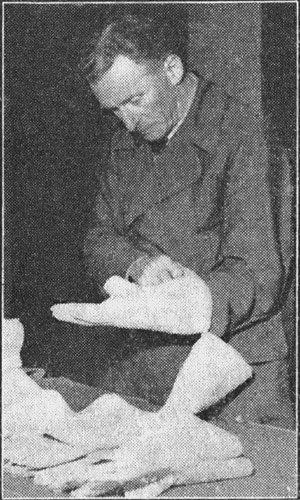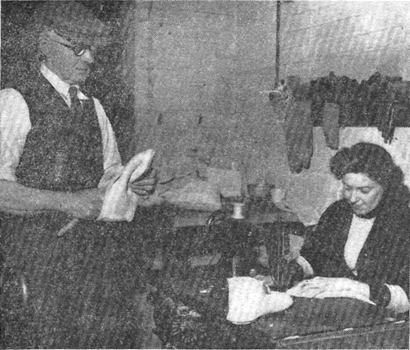|
It was 76 years ago when the late Mr. Thomas Coates opened a business at 52 High Street, Tonbridge, manufacturing a wide range of leather goods in his workshop behind his shop.
 |
Mr. N.V. Coates examines the finished products
|
There was a great demand for leather legging's at that time, and the production of this garment formed the greatest part of the firm's production, until just before the last war, when rubber footwear replaced the hand-made leggings.
In 1884 Mr. Thomas Coates was joined in his business by his son, Jabez, who spent a total of 67 years with, the firm. He died, only last year, at the great age of 84.
In 1891, Mr. Percy Coates, another son, joined his father. Mr. Percy Coates is still actively
engaged with the firm.
Although the firm has in the past employed many operatives, its present staff is five,
including Mr. Percy and Mr. Victor Coates.
Mr. Jabez Coates' son Victor joined the firm In 1920 and today, as well as keeping busy
at the factory, he is responsible for the representation and secretarial work of the firm.
The firm's present home was built in 1937. In the same year the firm was incorporated as a
private company.
During the war the firm continued its operations from a shop in Quarry Hill Road, while
the factory was being used as a store by the Ministry Supply.
Now for a peep behind the scenes of this small but efficient industry that is constantly improving its reputation.
The firm's present production is concentrated upon the making of slippers and industrial
gloves.
Entering a store room where the skins are kept, Mr. P. Coates said " We are rather empty at the moment; often this room is full of skins."
Three kinds of skin are used in the making of industrial gloves. A sheepskin, which
has the natural wool on one side, and is smooth on the other; a skin without any wool
on, and processed to make it harder wearing; and the tan sheepskin, which is a double-processed basil.
Working at the bench is Mr. Harry Roake, who has been with the firm for 34 years. He first cuts the skins into squares, and then finally presses them out, six pairs at a time. Forchettes are also cut from small strips of leather, which are then sewn between the fingers
of the gloves.
 |
Mr. Roake cutting gloves.
|
Hand Press
A large board, known as a Webb, in which are set a number of upright blades forming
the left and right-hand pattern, and size of gIove or mitten, is placed beneath a heavy
hand press.
The square skins are put on top of the "Webb" and the press is lowered. When it is raised, half-a-dozen or so glove patterns, with a hole cut for the thumb to be fitted, have been produced.
The composite pieces are now ready for stitching. This work said Mr. Coates, "is done by
outside machinists and hand sewers, because we are unable to get the staff."
A pair of gloves appear a difficult thing to make. Perhaps it was Mr. Coates' experience which made the job look comparitively easy.
A fleecy pair of warm and comfortable slippers are now put on the stand for inspection.
Again the manufacture looks surprisingly simple, but only because of the care and experience given to their production by a man who has been with this firm for 60 years. He is Mr. J. Payne, who although 73 years old, has a youthful smile.
Pair Of Slippers
 |
Mr. J. Payne & Mrs. I. Edwards making slippers.
|
Only three pieces of material are used to make a pair of slippers. A strip of leather
that, forms one side of the slipper, is cut to form the shape from the top to the toe.
A left and right side are made and sewn together by Mrs. Iris Edwards, the machinist, then the sole is added.
When this has been done Mr. Payne "blocks" the slipper into shape.
Unlike a shoe, a last is seldom used, then only when the "blocking" is done.
The wide distribution of these two worthwhile items is undoubtedly bringing further
laurels to this small firm that has built up a reputation over many years.
|